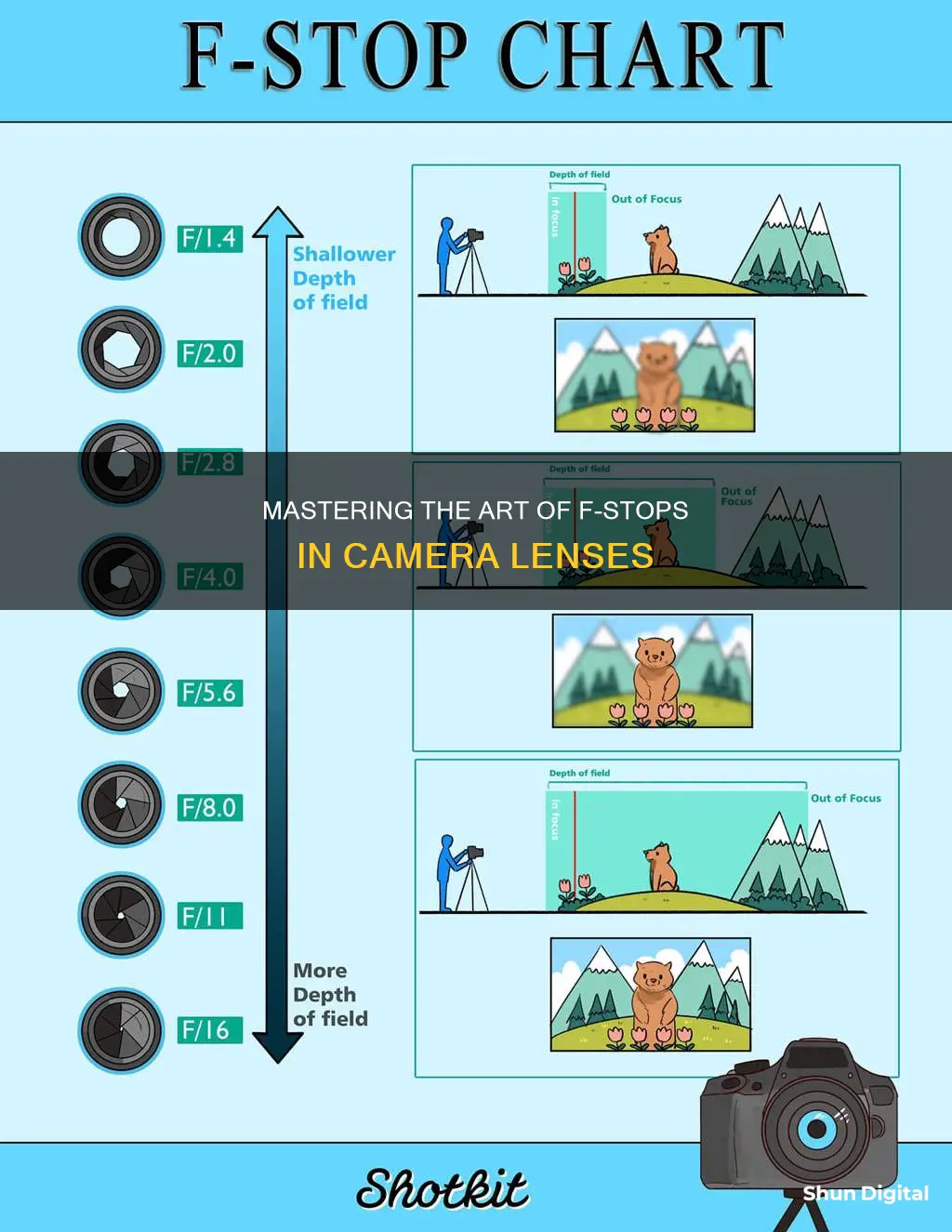
F-stops, also known as f-numbers, are a crucial aspect of photography, as they determine the amount of light that enters a camera lens. The f-stop is the ratio of the lens focal length to the diameter of the entrance pupil, and it plays a vital role in controlling exposure and depth of field. A lower f-number means a larger aperture, allowing more light to enter the camera, while a higher f-number results in a smaller aperture and less light entering the system. F-stops are marked with their corresponding f-number, and each stop halves the light intensity from the previous setting, impacting the brightness of the image. Understanding f-stops is essential for photographers to master their craft and create stunning visuals.
| Characteristics | Values |
|---|---|
| F-stop definition | F-stop, also known as f-number, is the ratio of the lens focal length to the diameter of the entrance pupil. |
| Focal length | The "f" in f-stop stands for the focal length of the lens. |
| Aperture | F-stop is the term used to denote aperture measurements on your camera. The aperture controls the amount of light that enters the camera lens. |
| Exposure | F-stop, along with shutter speed and ISO, is a fundamental component that makes up the exposure triangle in photography. |
| Depth of field | F-stop influences the depth of field in a photograph. Lower f-numbers result in a shallow depth of field, while higher f-numbers increase the depth of field. |
| Light gathering ability | F-number is a measure of the light-gathering ability of a camera lens. Lower f-numbers allow more light to enter the system, while higher f-numbers let in less light. |
| Maximum aperture | The lowest f-stop a lens can shoot with is called the maximum aperture. Zoom lenses often have a maximum aperture of f/2.8 or f/4, while prime lenses can handle wider apertures. |
| Shutter speed | F-stop and shutter speed work together to create exposure settings. A wider aperture (lower f-number) results in a shorter shutter speed, and vice versa. |
What You'll Learn
- F-stop measures the light-gathering ability of a camera lens
- F-stop is also known as the focal ratio, f-ratio, or aperture
- A lower f-number means a larger relative aperture and more light entering the system
- F-stop is calculated by dividing the system's focal length by the diameter of the entrance pupil
- F-stop settings help establish the look and feel of your photo

F-stop measures the light-gathering ability of a camera lens
F-stop, also known as the f-number, is a measure of the light-gathering ability of a camera lens. It is calculated by dividing the focal length of the lens by the diameter of the entrance pupil (or the "clear aperture"). The f-number is usually expressed using a lower-case hooked f with the format f/N, where N is the f-number. For example, an f-number of 2 would be written as f/2.
The f-stop controls the amount of light that passes through the lens at a given shutter speed. A smaller f-number (e.g. f/1.4) allows more light to pass through the lens than a larger one (e.g. f/16). This is because the f-number is the inverse of the relative aperture, which indicates how much light can pass through the lens at a given focal length. A lower f-number means a larger relative aperture, while a higher f-number means a smaller relative aperture.
The f-stop setting helps photographers get a proper exposure and establish the look and feel of their photo by determining the depth of field. Larger apertures (smaller f-numbers) let in more light and create a shallow depth of field, making them useful for low-light scenarios and portrait photography. Smaller apertures (larger f-numbers) let in less light and create a wider depth of field, making them suitable for landscapes and well-lit scenes.
The range of f-stops that can be used depends on the camera lens. The lowest f-stop a lens can shoot with is called the maximum aperture. Zoom lenses typically have a maximum aperture of f/2.8 or f/4, while prime lenses can handle wider apertures due to having fewer moving parts. Faster lenses with larger apertures tend to be more expensive, while slower lenses with smaller apertures are more budget-friendly.
By adjusting the f-stop, photographers can control the amount of light entering the lens and create different visual effects. This, along with shutter speed and ISO (sensitivity to light), forms the exposure triangle, which is key to determining the final look of a photograph.
Choosing Camera Lenses: A Guide to Perfect Photography
You may want to see also

F-stop is also known as the focal ratio, f-ratio, or aperture
F-stop, also known as the focal ratio, f-ratio, or aperture, is a crucial concept in photography. It refers to the amount of light that enters the camera lens and plays a vital role in determining the exposure and style of your photograph.
The "f" in f-stop stands for focal length, and the f-stop value is calculated by dividing the lens's focal length by the diameter of the entrance pupil or aperture. This ratio is expressed as a fraction, with "f" as the numerator and the f-stop number as the denominator. For example, an f-stop of f/2.8 means the focal length is 2.8 times larger than the aperture.
The f-stop setting impacts the depth of field in your photograph. A lower f-stop, such as f/1.4, f/2, or f/2.8, creates a shallow depth of field, making it ideal for portrait photography as it keeps the subject in focus while softening the background. On the other hand, a higher f-stop like f/8, f/11, or f/16 results in a greater depth of field, making it suitable for landscape photography to capture both foreground and background details in sharp focus.
F-stop also influences the brightness of your image. A larger aperture, denoted by a lower f-stop number, lets in more light, resulting in a brighter image. Conversely, a smaller aperture, represented by a higher f-stop number, allows less light to pass through, leading to a darker photograph.
It's important to note that the range of f-stops available depends on your camera lens. The lowest f-stop achievable is called the maximum aperture, and it varies depending on the type of lens. Prime lenses, with fixed focal lengths, often offer wider apertures due to their simpler construction.
Understanding f-stops is essential for photographers who want to have full creative control over their images. By adjusting the f-stop, photographers can manipulate the depth of field and brightness, creating stunning visual effects that enhance the overall look and feel of their photographs.
Understanding Camera Lenses: Describing the Basics
You may want to see also

A lower f-number means a larger relative aperture and more light entering the system
The f-number, also known as the f-stop, is a measure of the light-gathering ability of a camera lens. It is calculated by dividing the focal length of the lens by the diameter of the entrance pupil. The f-number is also known as the focal ratio, f-ratio, or inverse relative aperture.
A lower f-number means a larger relative aperture, allowing more light to enter the camera system. This is because the f-number is the inverse of the relative aperture, which is defined as the aperture diameter divided by the focal length. So, a lower f-number indicates a larger aperture diameter, which lets more light through the lens at a given focal length.
For example, a lens with an f-number of f/2 will let in more light than a lens with an f-number of f/4, as the aperture diameter of f/2 is larger. This is an important concept in photography, as the amount of light entering the lens directly impacts the brightness and exposure of the photograph.
A larger aperture (low f-number) is useful in low-light scenarios and is commonly used in portrait photography. It creates a shallow depth of field, making the subject stand out while the background blurs. On the other hand, a smaller aperture (high f-number) is often used in landscape photography to capture a wide depth of field, with almost everything in the frame in focus.
The range of f-stops a camera can shoot with depends on the lens. The lowest f-stop a lens can shoot with is called the maximum aperture. Zoom lenses often have a maximum aperture of f/2.8 or f/4, while prime lenses can handle wider apertures due to having fewer moving parts.
Understanding the relationship between f-number and aperture size is crucial for photographers who want full control over their images. By adjusting the f-stop, photographers can manipulate the amount of light entering the lens and, consequently, the exposure and depth of field of their photographs.
Cleaning Camera Lenses: Removing Rubber Residue
You may want to see also

F-stop is calculated by dividing the system's focal length by the diameter of the entrance pupil
F-stop, or f-number, is a measure of the light-gathering ability of a camera lens. It is calculated by dividing the system's focal length by the diameter of the entrance pupil ("clear aperture"). The f-number is also known as the focal ratio or f-ratio, and it is key in determining the depth of field, diffraction, and exposure of a photograph.
The f-number is calculated using the formula: N = f/D, where N is the f-number, f is the focal length, and D is the diameter of the entrance pupil. For example, if a lens has a focal length of 100mm and an entrance pupil diameter of 50mm, the f-number would be 2, expressed as f/2.
The f-number is related to the aperture of the lens, which is the hole in the middle of the lens made up of rotating blades that open to let in light. The aperture size is inversely related to the f-number, so a smaller f-number corresponds to a larger aperture, allowing more light to enter the system. This is an important concept in photography, as it affects the brightness and depth of field of a photograph.
The f-stop number refers to the size of the aperture opening and can be calculated by dividing the lens's focal length by the f-number. For example, a 200mm lens with an f/4 aperture would have an aperture diameter of 50mm (one-quarter of 200mm).
By adjusting the f-stop, photographers can control the amount of light that passes through the lens, which in turn affects the exposure and depth of field of the image. A lower f-number results in a larger aperture, allowing more light to enter the camera and creating a shallower depth of field. On the other hand, a higher f-number results in a smaller aperture, letting in less light and creating a greater depth of field.
Lens Compatibility: Understanding Camera Lens Interchangeability
You may want to see also

F-stop settings help establish the look and feel of your photo
F-stop settings are a crucial aspect of photography, allowing you to establish the look and feel of your photos by controlling the depth of field. The depth of field refers to the range within a scene that appears in focus, and it can be manipulated by adjusting the aperture size, which is denoted by the f-stop value.
The f-stop setting impacts the amount of light that enters your camera lens and, consequently, the brightness of your photo. A lower f-stop value, such as f/1.4 or f/2, represents a larger aperture opening, allowing more light to enter the camera. This results in a shallow depth of field, making it ideal for portrait photography as it keeps the subject in focus while softening the background. On the other hand, a higher f-stop value, such as f/16 or f/22, indicates a smaller aperture, reducing the amount of light entering the camera and resulting in a deeper depth of field. This is often used in landscape photography to ensure that both the foreground and background remain in focus.
The "f" in f-stop stands for "focal length", which refers to the field of view of the lens. By adjusting the f-stop, you control how much light passes through the aperture opening and hits the sensor, directly influencing the brightness of your photo. The aperture itself is composed of rotating blades that open and close, creating a near-perfect circle to let in light when you press the shutter release.
The range of f-stop values you can use depends on the camera lens you are working with. Zoom lenses often have a maximum aperture of f/2.8 or f/4, while prime lenses, with their fixed focal length, can handle wider apertures due to having fewer moving parts. The choice of lens depends on the type of photography you are doing. For astrophotography, a wider aperture of f/2.8 or more is essential to capture images in low-light conditions. In contrast, landscape photographers shooting in broad daylight may not require such a wide aperture.
Experimenting with different f-stop settings is a great way to understand their impact on your photos. By adjusting the aperture, you can create various effects, from dreamy, blurry backgrounds to crisp, fully-focused landscapes. Play around with the settings, review your photos, and you'll soon develop a feel for how f-stop settings contribute to the look and feel of your images.
Best Budget Camera Lenses: Enhance Photography Under $200
You may want to see also
Frequently asked questions
F-stops, also known as f-numbers, refer to the aperture size on your camera or lens. They control the amount of light that passes through the lens at a given shutter speed.
You can adjust your f-stop settings by entering your camera's aperture-priority mode or manual mode. This will allow you to pick the aperture size you want.
A large f-stop, such as f/1.4, f/2, or f/2.8, lets in more light and creates a shallow depth of field, making it ideal for low-light photography and portraits. A small f-stop, such as f/8, f/11, or f/16, lets in less light and creates a wider depth of field, making it better suited for landscape photography or well-lit scenes.







